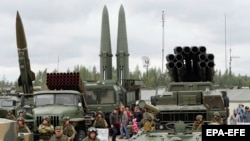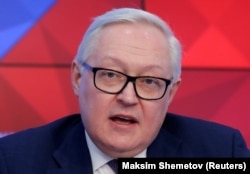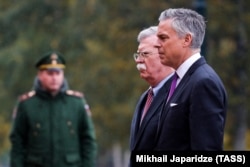A nuclear treaty involves many complicated issues. And we will get to those in the narrative lower in this article. We thought it would be helpful to break down the claims and counterclaims involving the Intermediate-Range Nuclear Forces (INF) Treaty before directly addressing the details that lead to the Polygraph.info verdict:
What the US Claims
U.S. Government: The U.S. has said since 2014 that Russia is in violation of the INF Treaty, though very few of the details have been made publicly available. In 2017, the State Department did reveal the missile in question -- the 9M729. In 2018, the U.S. ambassador to Russia said the U.S. had provided “geographic coordinates” and the dates of tests showing the violations.
Russian Response: The Russian government consistently denies violations.
Third Party: The director of the Russian Nuclear Forces Project, an independent academic research project, insists the U.S. could have only “indirect” evidence -- that the rocket had not been tested to distances that would verify a violation. The indirect evidence could include “detailed blueprints of the missile and all its technical characteristics.”
The Dutch government says it has verified, based on its own independent intelligence, that Russia is developing a cruise missile in violation of the treaty.
What Russia Claims
The Russian Government: The government says the U.S. the Aegis Ashore missile defense system and a vertical launcher deployed in Romania could be used for offensive missiles.
The U.S. Government: The Aegis was developed as a purely defensive system to protect U.S. Navy ships. The U.S. claims the newer, land-based Aegis also is defensive.
Third Party: The Arms Control Association’s executive director says the Aegis system can be equipped with offensive weapons, though he adds these "are not equivalent problems."
The Verdict
We find President Putin’s words to be misleading. The 9M729 missile that is already deployed in European Russia is a threat to a number of European countries, whatever claims to its are accurate -- the Russian or the U.S.
The Details – a Narrative
During a February 2 televised working meeting between Russian President Vladimir Putin, Defense Minister Sergei Shoigu and Foreign Minister Sergei Lavrov, that day’s decision by the Trump administration to withdraw from the 1987 Intermediate-Range Nuclear Forces (INF) Treaty on February 2 was the chief topic.
Lavrov said Moscow had done “everything” to save the INF Treaty, given its “importance in terms of sustaining strategic stability in Europe, as well as globally.” Shoigu said the country would develop new types of weapons, including a ground-based long-range hypersonic missile system.
Despite placing all of the blame on the U.S., Putin said Moscow would not place short- or medium-ranged weapons “in Europe or in other regions of the world” if analogous U.S. weapons were not deployed in corresponding regions.
"For many years, we have repeatedly raised the issue of substantive negotiations on disarmament issues, in almost all its aspects. And in recent years, we see that our partners do not support our initiatives. On the contrary, all the time pretexts are sought out for dismantling the already established system of international security,” Putin said.
Arms Control Association: 'The Start of a Conversation'
Daryl Kimball, executive director of the Arms Control Association, told Polygraph.info that President Putin’s proposal is “the start of a conversation,” but ultimately Moscow would be required to remove “those missiles that it has already deployed to locations further in the east so they cannot hit targets in Europe.”
He added: “That would calm the waters in the absence of the INF Treaty. It’s not an ideal solution but it’s one way to avoid each side from rushing to develop and deploy prohibited missiles.”
Kimball’s assertion that Russia will “ultimately” need to move the missiles reflects the State Department’s 2014 assessment that Russia was in violation, despite a later congressional assessment the U.S. “did not offer any details.”
The State Department Report
The U.S. Department of State Arms Control, Verification and Compliance Bureau, in an unclassified April 2018 report, “determined” that Russia “continued to be in violation of its obligations under the INF Treaty not to possess, produce, or flight-test a ground-launched cruise missile (GLCM) with a range capability of 500 kilometers to 5,500 kilometers, or to possess or produce launchers of such missiles.”
It identified the Russian missile as the SSC-8 (Novator 9M729), and added details that covert development began in the mid-2000s, testing soon afterward. An independent report indicated the Novator had not been tested beyond INF limits even as late as 2015.
The State Department report concluded:
- The GLCM has a range capability between 500 and 5,500 kilometers, a treaty violation;
- It is distinct from an earlier version; and,
- The missile is distinct, with the Russian designation as the 9M729.
A January 2019 Congressional Research Service report noted that Russian diplomats had proposed that Russia display the 9M729 “and demonstrate that it could not fly to INF range…” The U.S. rejected this proposal, arguing inspection was not enough to verify and demanding Russia destroy the missile.”
After U.S. National Security Council official Christopher Ford revealed the the 9M729 in a November 29, 2017 speech, Pavel Podvig, director of the Russian Nuclear Forces Project, an independent scientific analysis organization, said the designation, alone, did not mean much.
In December 5, 2017 blog post, Podvig said he had earlier suspected the missile in question had “not been tested to the INF range from a mobile ground-based launcher,” adding he was certain that suspicion was correct.
“This means that the evidence of a violation is indirect,” he said.
Podvig noted that under the INF Treaty, actual testing is not required if it can be proven a missile’s capabilities exceed the range. He posited that either U.S. intelligence “has detailed blueprints” or, more likely, the missile is “almost identical” to another that was tested, the sea-launched Kalibr.”
By February 4, 2019, the U.S. claimed it knew Russia had flight tested the 9M729 to distances well over 500 kilometers.
US: 'Geographic Coordinates' and Test Dates
“The United States has provided Moscow with substantial information about this system’s violations, including geographic coordinates and dates for the tests, but Russia continues to deny any wrongdoing,” U.S. Ambassador to Russia John Huntsman wrote.
Likewise, Dutch Foreign Minister Stef Blok and Defense Minister Ank Bijleveld wrote a letter last November stating that “based on intelligence …The Netherlands can independently confirm that Russia has developed and is currently introducing a ground-based cruise weapon.”
But neither country provided specific details.
NATO foreign ministers released a statement supporting the U.S. position regarding the alleged Russian violation, following a meeting December 4.
Asked why the U.S. had not disclosed related information to publically bolster its case, Kimball said U.S. intelligence likely “did not want to compromise its sources or methods.”
“Methods by which the U.S. has gathered the information are very sensitive and parts of the U.S. government, the intelligence community in particular, are reluctant to provide that information,” he told Polygraph.info.
But Kimball added that if Russia is in the wrong, “we need to show that Russia is in the wrong” by providing “information that third parties can see that undergirds the U.S. case.”
Russian Claims on the Missle Are Inconsistent
Meanwhile, the CRS report quoted Russian Deputy Foreign Ministry Sergey Ryabkov calling the U.S. claims “fabrications” that are “inconsistent with reality.”
Ryabkov claimed the 9M729 is an “upgraded” version of the Iskander-M system missile whose maximum range was demonstrated at the Kapustin Yar testing ground in Astrakhan, southern Russia, as less than 480 kilometers, not an INF violation.
As Polygraph.info has reported recently, the Russian Defense Ministry displayed the 9M729 missile at an expo center in Moscow in January, and said more than 100 missile launches were conducted over the six years from 2008 to 2014 at the Kapustin Yar missile range in southern Russia.
But Zvezda, the Defense Ministry’s official TV channel, quoted the commander of the Russian military’s missile and artillery forces, as indicating that some of these launches in fact exceeded the INF Treaty’s 500-kilometer range limit.
US Aegis Ashore
“Rather than addressing U.S. concerns, Russia chose to claim that U.S. ballistic missile defense targets, Aegis Ashore missile defense systems in Poland and Romania, and armed UAVs violate the treaty,” the U.S. ambassador, Huntsman wrote. “In contrast, the United States has responded in detail to these false Russian claims, demonstrating that we diligently comply with our treaty obligations in full.”
But Kimball said that while some of Russia’s claims are “an attempt to create a counter-narrative,” others “should be responded to in a much more serious way.”
He noted that Russia has a legitimate concern that the Aegis Ashore missile-defense systems and the Mk-41 Vertical Launching systems deployed in Romania can be used for offensive missiles.
“Russia modifying the 9M729 or getting rid of it [in exchange for] the U.S. agreeing to measures that we won’t use Aegis Ashore and that we won’t launch missiles into their territory [are options on the table],” Kimball told Polygraph.info. “These are not equivalent problems – they are not both violations – but there is obvious trade space,” he added, should the two countries chose to continue negotiating.
But he added neither the Trump administration nor Moscow are as “interested in solving this problem as they should be.”
A recent report by the Wall Street Journal that Russia has already deployed four battalions of the 9M729 further chips away at Putin’s claim of compliance.
With Russia’s recent admission of test violations, and reports the missile is deployed, Putin’s claim that Russia will not place short- and medium-range weapons in Europe is moot and Polygraph.info finds Putin’s statement is misleading at best.











